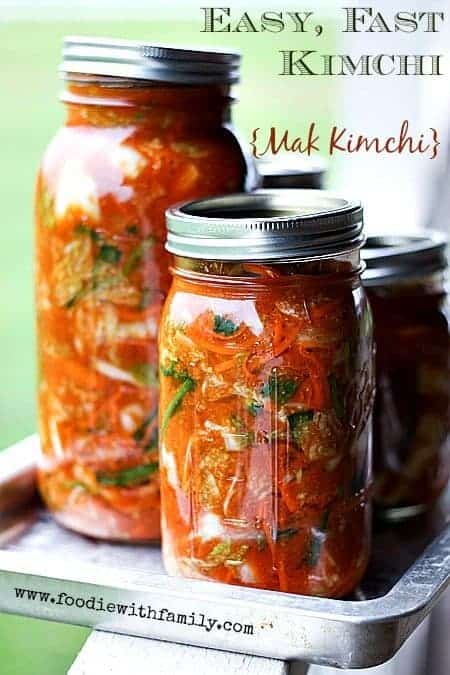
Love this Easy, Fast Mak Kimchi recipe? Check out our other fabulous Korean Food Recipes!
If you’ve been with me for a while, you’re well aware of my undying love for kimchi. Yes, it is stinky and bubbly and more than a little wild, but WOWZA the taste and the texture are so worth it.
If you’re new to the Foodie with Family family and you aren’t familiar with kimchi, I can give you a super condensed description; it’s essentially spicy, aromatic Korean sauerkraut. Today, I’m bringing you a fool-proof Easy Fast Kimchi recipe {Mak Kimchi}.
What is Kimchi?
Kimchi comes in almost as many forms as there are vegetables because nearly any vegetable can be fermented. They range from super mild smell to mega funky and mellow to melt-your-face-off spicy and there is one for every possible point in between.
The kimchi recipe that I’m sharing today is my family’s favourite version. It’s chock full of fabulous pro-biotics (as most kimchi is) and the longer it ages (translation: ferments) the stronger it becomes in both flavour AND pro-biotic content.
It’s like yogurt on steroids, people. That’s how good it is for you!
Is Kimchi Good For You?
Health Magazine named kimchi one of it’s Top 5 World’s Healthiest Foods. It is is low in calories and fat and high in dietary fiber and wicked high in Vitamins A, B, and C.
Many (if not most) Koreans eat a little kimchi with each meal or at least once a day. Kimchi is credited with helping most Koreans avoid obesity by virtue of its ability to satisfy even while being low calorie and low fat.
Seoul National University conducted a study and claimed that chickens infected with the H5N1 virus, also called avian flu, recovered after eating food containing the same cultured bacteria found in kimchi. That’s good enough for me!
How to Make Kimchi
Let’s get cracking and make some kimchi, shall we? The variety we’re making today is an Easy, Fast Kimchi recipe or Mak Kimchi…
In other words, it’s already cut up and ready to shovel into your mouth. Unlike what is usually just called ‘kimchi’ which is whole heads of napa cabbage smeared with the kimchi paste and allowed to ferment all wrapped up.
This version is FAR easier to make and far faster to be ready. Bonus, it is way easier to eat straight from the jar with a pair of chopsticks or a fork.
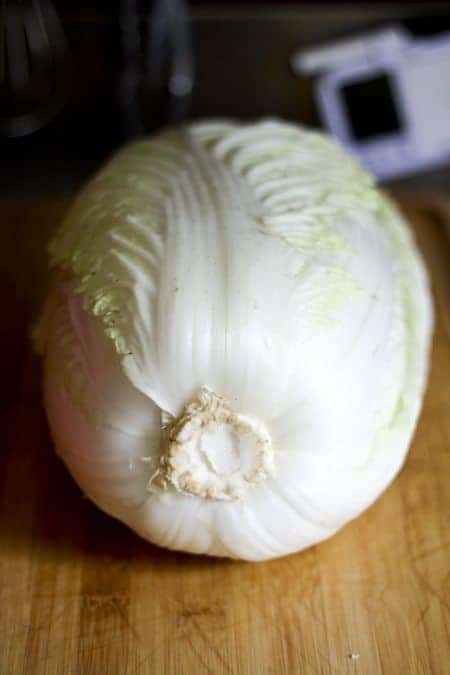
Do I need special tools to make kimchi?
In short, no. All you really need is a knife, a cutting board, and a big bowl. You will need a couple of ingredients that you may not have purchased before, but never fear, they’re not hard to find these days and I’ve included links to them below.
To begin with, you’ll need a big old head or two of Napa cabbage. I had two heads like the one above weighing in at about 3 pounds each.
It yielded, when all was said and done, about 3 quarts of kimchi, so that was perfect for me. You can cut that back if you think you can’t consume that amount of our Easy, Fast Kimchi recipe or Mak kimchi.
But I find all sorts of places to tuck it in, so it’s not an issue here and it’s only my husband, myself, and two of our boys who eat it. We love our kimchi.
Kimchi Recipe
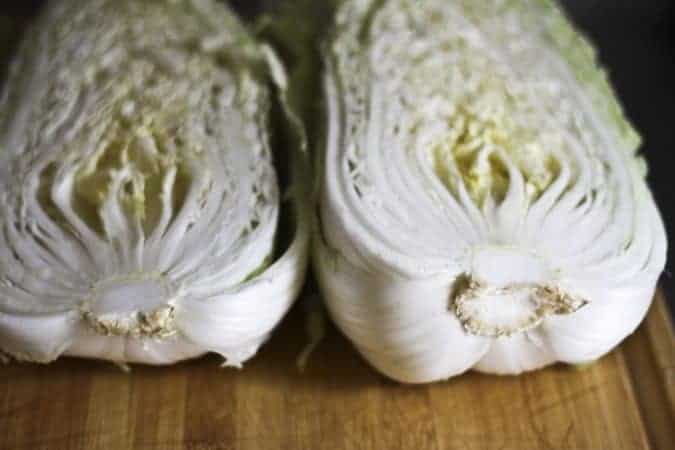
Lob your cabbages in half lengthwise. Use a paring knife to remove the gnarly core from them before cutting in half lengthwise again, leaving you with quarters.
Cut across the quarters to make bite-sized squares of cabbage. I usually shoot for 2-inch squares.
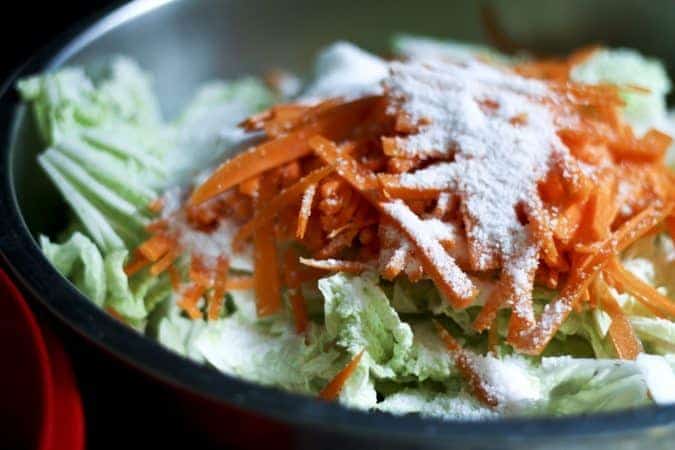
Add the cabbage to a monstrously huge bowl (or bowls), top with the julienned carrots, and sprinkle salt over the whole works. Toss the veggies and massage the mixture until the cabbage just starts to wilt.
Pour in enough cold water to over all the cabbage and carrots by a bit. It doesn’t have to be swimming in water, just covered.
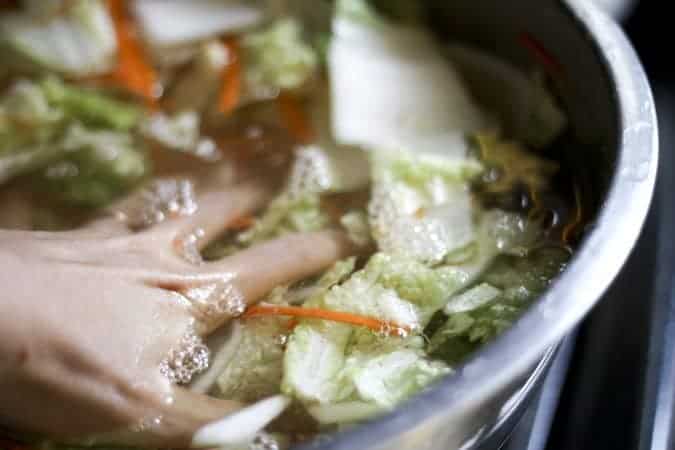
Stir it up with your hands and let it rest at room temp for a couple of hours.
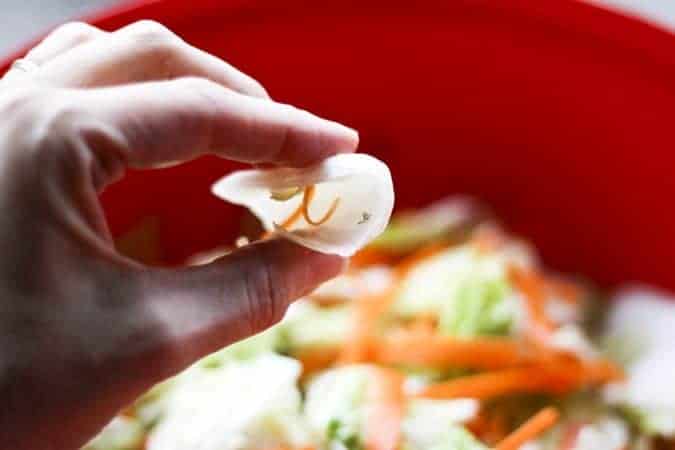
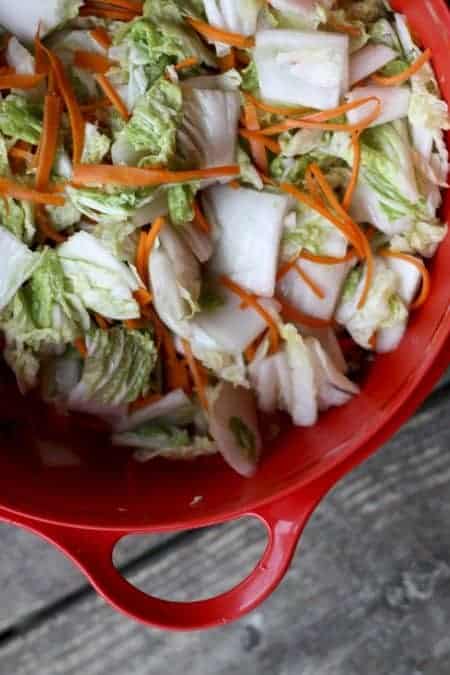
After a couple of hours, when the sturdier pieces of cabbage have become flexible, pour the whole lot into a strainer and let the brine water drain away.
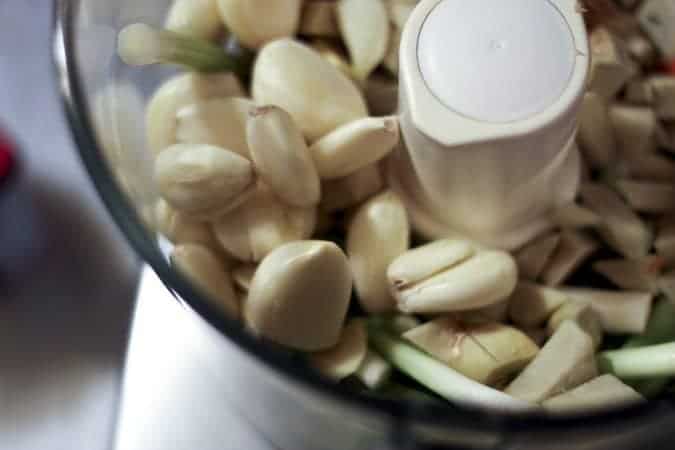
Now you’re going to whizz up the good stuff. Garlic, ginger, the white parts of scallions, Korean Red Pepper Powder*, fish sauce, unsweetened pear or apple juice, miso paste, and whatnot go into the food processor or blender.
Obliterate and smash it all into a lovely, red, fabulous smelling paste. It’s worth noting that you shouldn’t just up and increase the garlic because it can make kimchi linger more on your breath than you’d like it to do.
It also tastes out of balance if you add a lot more. Be aware.
And by the same token, you shouldn’t increase the ginger willy-nilly because that can make the final product a little more bitter than you’d like it to be. Start with the mixture and proportions I’m giving you and then play with it in subsequent batches.
*It’s important to note that you cannot use American or Mexican Chili Powder in place of the Korean pepper powder here. They’re COMPLETELY different animals. It may end up tasty, but I haven’t tested it so I cannot speak to it.
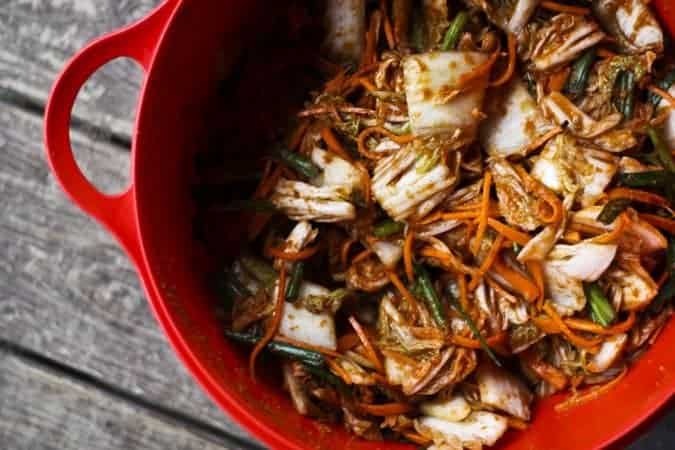
Now you’ll CRAM this stuff into jars or food-safe plastic containers. When I say cram it, I mean shove it in there as firmly as you can without putting your fist through the bottom of the jar.
I do prefer glass canning jars, if you’re wondering, because they don’t retain odors like plastic does, and, well, this stuff is odiferous! You can use a dedicated plastic kimchi bucket if you’d prefer, though.
Gently place a lid and ring on the jar, but don’t screw it tightly into place because BOOM. It’ll pop. This is active stuff, mes amies!
Place the jar on a rimmed pan or baking dish. The rim is pretty crucial here, because as the kimchi ferments at room temperature (and more slowly but still actively in the refrigerator) it will bubble up and may release a little juice over the edge of the jars.
In other words, you could have a kimchi river a-flowin’ on your counter top unless you take precautions. It’s easiest to use the pan and not worry about your Easy, Fast Kimchi recipe or Mak Kimchi bubbling over onto your counters.
It’s going to spend a couple of days at room temperature getting bubbly and fragrant. Every day, you’ll insert a clean chopstick or butter knife into the jar to help release air bubbles and top the jar off with extra brine if needed to keep everything submerged.
When it’s almost carbonated looking (usually between 24-72 hours after packing the jars), it’s ready to refrigerate. I highly recommend refrigerating it on the tray you used to contain the Grand Kimchi River while it fermented.
There aren’t a lot of things quite as unnecessary as removing everything from a fridge and mopping kimchi juices off of it. Take my word for it.
How long can I keep homemade kimchi?
It’s ready to eat at that point! Of course, it gets stronger and more kimchi-y the longer it sits. I love cooking with the older stuff and eating the newer stuff ‘raw’.
One of my all-time best-loved ways to eat older kimchi is in pancake form. Not like Aunt Jemima pancakes or flapjacks, but savoury, crispy-edged, kimchi-studded, pan-fried, snack cakes that convert even die-hard kimchi skeptics.
It’s the only way my eldest likes kimchi, but OH how he loves it this way. And the smell of kimchi pancakes while they cook is irresistible.
Bonus: This stuff lasts just about forever when you make sure the veggies are submerged in the brine. It’s hard to go wrong.
What can I make with my kimchi recipe? How do I use kimchi?
-Kimchi Fried Rice AND another version of Kimchi Fried Rice (the second one has a fried egg on top. SWOON!)
-Korean Army Stew- Budae Jjigae
-Kimchijeon (Savoury Kimchi Pancake)
Kimchi Ingredients
Kimchi
Cut the napa cabbage in half longways, then in half again longways. Cut the core out of the four quarters.
Cut the cabbage into squares (about 2-3 inches square), pop it in a bowl with the carrots. Sprinkle with the 1/2 cup kosher salt, massage so everything is coated in salt and starting to soften and wilt. Fill with cold, chlorine free water to cover it well and let it soak for at least 1 1/2 hours.
Pour the cabbage and carrots and liquid into a strainer. Let the brine drain away.
Lob off the white bits of the green onions and put them in a food processor with the garlic cloves, ginger, miso paste, and korean pepper powder. Zap it on high ’til it’s smooth-ish. Add in the fish sauce and a couple of slops of pear juice and zap it more until it’s about pancake batter consistency… maybe a bit thinner.
Put the brined cabbabe/carrots in a big, anti-reactive (glass, enamel, or stainless steel) bowl. Rough chop the green parts of the onions and add those to the cabbage/carrots. Pour the chili paste combo over the cabbage and wear gloves to massage it all over the cabbage/carrots green onions so everything is completely covered.
Pack super tight in canning jars. CRAM it in there.
Add a two-piece lid, but just set the ring in place to hold the lid down without screwing it in place. Place it on a rimmed baking dish to catch any spill-over.
Let it sit at room temperature for up to 72 hours, until it is bubbly and fragrant. Once every day, insert a clean chopstick or butter-knife to release air bubbles. If needed, pour in some additional brine to keep all the vegetables submerged.
Store on a rimmed sheet in the refrigerator for up to six months, being sure that the vegetables are submerged the whole time. The older it gets, the stronger it will become.
Notes
If you need extra brine to keep your vegetables submerged, please combine 1 quart of cool water with 4 teaspoons of kosher salt in a quart jar with a tight fitting lid and shake until the salt is dissolved. Use it to top off the vegetables as needed.
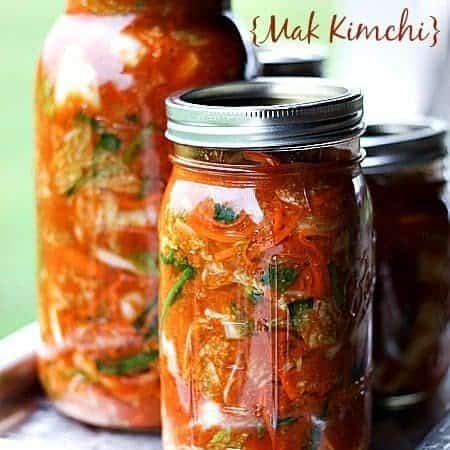
Easy, Fast Kimchi Recipe {Mak Kimchi}
Rate RecipeIngredients
- 3-8 pounds napa cabbage
- 2 bunches green onions trimmed of the root bits
- 2-3 large carrots peeled, thinly julienned
- 1/2 cup kosher salt
- 1/2 cup korean chili powder
- 15-20 cloves garlic overdoing garlic makes this stay on your breath more than usual., peeled
- 4-6 inches ginger peeled, rough chopped
- 1 tablespoon fish sauce
- unsweetened pear juice or unsweetened apple juice
- 4 tablespoons white miso paste
Instructions
- Cut the napa cabbage in half longways, then in half again longways. Cut the core out of the four quarters. Cut the cabbage into squares (about 2-3 inches square), pop it in a bowl with the carrots. Sprinkle with the 1/2 cup kosher salt, massage so everything is coated in salt and starting to soften and wilt. Fill with cold, chlorine free water to cover it well and let it soak for at least 1 1/2 hours.
- Pour the cabbage and carrots and liquid into a strainer. Let the brine drain away.
- Lob off the white bits of the green onions and put them in a food processor with the garlic cloves, ginger, miso paste, and korean pepper powder. Zap it on high ’til it’s smooth-ish. Add in the fish sauce and a couple of slops of pear juice and zap it more until it’s about pancake batter consistency… maybe a bit thinner.
- Put the brined cabbabe/carrots in a big, anti-reactive (glass, enamel, or stainless steel) bowl. Rough chop the green parts of the onions and add those to the cabbage/carrots. Pour the chili paste combo over the cabbage and wear gloves to massage it all over the cabbage/carrots green onions so everything is completely covered.
- Pack super tight in canning jars. CRAM it in there. Add a two-piece lid, but just set the ring in place to hold the lid down without screwing it in place. Place it on a rimmed baking dish to catch any spill-over. Let it sit at room temperature for up to 72 hours, until it is bubbly and fragrant. Once every day, insert a clean chopstick or butterknife to release air bubbles. If needed, pour in some additional brine to keep all the vegetables submerged.
- Store on a rimmed sheet in the refrigerator for up to six months, being sure that the vegetables are submerged the whole time. The older it gets, the stronger it will become.
Notes
Nutrition
Nutritional information is an estimate and provided to you as a courtesy. You should calculate the nutritional information with the actual ingredients used in your recipe using your preferred nutrition calculator.
did you make this recipe?
Make sure to tag @foodiewithfam on Instagram and #hashtag it #foodiewithfamily so I can check it out!
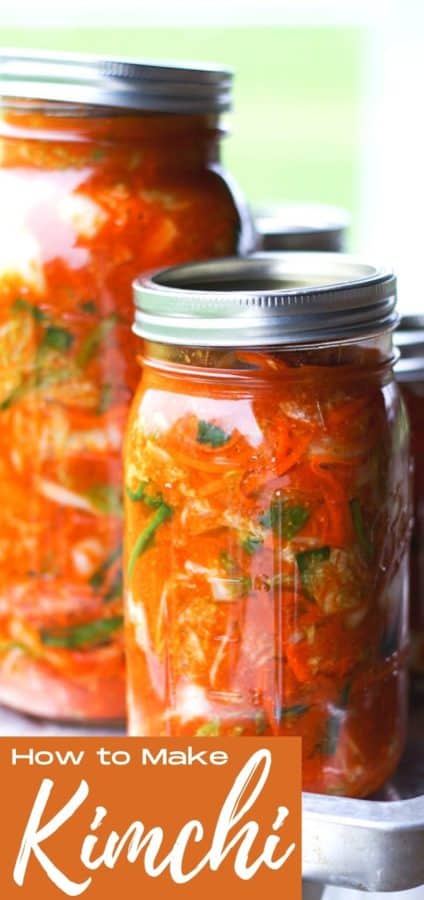
This post was originally published on December 2, 2013 and was updated December 28, 2016, June 2018, and September 2021.
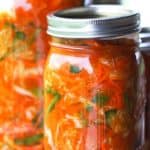



Reader's Thoughts...
stephanie says
It says 3-8 lbs of cabbage, how do i measure the remainder of the ingredients if i use 8 lbs rather than 3?
Rebecca says
Hi Stephanie- There is a large range here, but the paste you make should be sufficient to work for up to 8 pounds of cabbage. 🙂
June Reith says
Hi Rebecca was fingering through all your messages trying to find one that I left before I made it and couldn’t find it normally messages the latest messages are on the top but they’re on the bottom so it’s a bit confusing I want to say thank you …I love the kimchi recipe that you gave us I made the kimchi pancake and took it down to the dog club and they all loved it .my friends got kimchee in the cupboard and not in on the in the fridge mine starting to get a bit of mould is still in the benchtop after about the after about another three weeks so should I screw the lid on and put it in the fridge June Western Australia
Rebecca says
Hi June! Thanks so much for the kind words. If your kimchi has mold, you should not eat it, unfortunately. This is part of why you store it in the refrigerator after the initial 3 day fermentation on the counter. I wouldn’t clamp the lid down tight, though. Rather, you should put the lid loosely in place and put the jar of kimchi in a bowl or container that can get any juices that bubble over.
Judy says
Thank you so much for the detail you have gone into to deliver us the yummiest recipe ever!
My tummy thanks you for all those wonderful millions of probiotics.
Rebecca says
Thank YOU, Judy! I appreciate you taking the time to let me know!
Pete says
I make mine pretty much the same way, but without the carrots. The only commercial brand sold near me is King’s Kimchi and mine is like that. For those without Koreqan pepper powder that want to try it, Sriracha sauce is a pretty good substitute. I used it my first time, while waiting for the big bag of pepper powder I ordered online to show up. I have also used Bok Choy in place of Nappa, that was good too.
Freeman says
Thanks for the sauce recipe. I make my own infrequently enough to not remember all the ingredients. I used “regular” cabbage, collards (a local ‘southern’ staple green), parsnips instead of carrot or diakon radish, because of it being somewhere in between the two, and green onions. Even before adding the sauce, the flavor was sublime. Thanks again for the inspiration for the sauce! Have a great day!
Rebecca says
That sounds outstanding, Freeman! Like a southern kimchi!!
Laurie says
I have a brand called “Mother In Law’s Gochugaru” Korean chili FLAKES. Not powder. It’s so delicious! But what amount would I use in this recipe to replace the powder with flakes? I’m assuming I’d use more? Your recipe seems perfect and I can’t wait to try it. Thanks in advance for your considered reply. 🙂
Rebecca says
Hi Laurie- I think I’m familiar with that particular brand and I think you can use it one-for-one. Korean chili powder isn’t like American chili powder. It’s definitely a bit flakier. If you like things extra hot, though, feel free to bump it up a bit. 🙂
Brandy says
Do I need the miso and fruit juice or can I omit those?
Rebecca says
Hi Brandy- I like them both in there for different reasons. The pear juice is nice to balance the flavours and give the fermentation some natural sugars to work on and the miso is good for both balancing flavours and giving that fermentation a little kick-start. I have not tried it without either or both, so I’m not sure what to tell you on that front. If you try it minus those ingredients, please let me know how it turns out for you.
Kristine says
Hi! So far I’ve only had one version of Kimchi that I really liked, but I can’t remember the name of it 🙁 and I’ve tried making it twice, but it’s not quite to my taste, so I’ll try making this recipe and seeing if it fits the bill. By the way, how long do you suggest waiting until trying to make the Kimchi pancake? The idea sounds awesome, and I really want to give it a try.
Rebecca says
Hi Kristine! I like the older, funkier kimchi for the pancakes, so ideally, I’d wait a few weeks before making it. That said, it’s still delicious with young kimchi, and it’d be fun for you to compare the results of the young with the results of the old. 🙂 Let me know what you think!
Abby says
I have yet to make this but I’m gathering up ingredients now. I am on a low sodium diet and was wondering if i can reduce any of the salt? I would love to be able to eat more than an ounce a day. Lol!
Rebecca says
Hi Abby- You really do need the salt both to help break down the cell walls in the vegetables and also to help control the bacteria in the fermentation, but please keep in mind that most of the salt is rinsed away when you drain the soaked vegetables. You could also rinse them a bit if you’d like to help remove more of the salt-water.
There is, of course, also sodium in the miso and fish sauce. Omitting either of these would definitely change the flavour profile of the finished kimchi. If you’d like, you could probably reduce those by about 1/3 so you’d still have the flavours but a little less sodium. 🙂
June Reith says
I followed all your instructions making the kimchi got the special powder but unfortunately I didn’t have any apple and pear juice so I just blended an apple with a yes with the Pulp iaswell and put a little bit of the brine in the in the blender I’ve made i6hours ago and there’s only one bubble in one of the 9 jjars so have I stuffed it up. —I hope not please let me know because the way you were talking it should be brimming over and it’s not
Rebecca says
Hi June- I think you’ll be fine! No worries. Give it a little more time and watch it. As long as the veggies are submerged in the liquid, you’ll be fine.
Hayden says
Great recipe, made a couple of monstrously huge bowls a few days ago! Deleting coins! Thank you!
Candy says
I didn’t have jars I put in tuperwhere is that ok
Rebecca says
I think that’s fine, Candy, but you’ll likely be unable to use that particular tupperware for anything but kimchi or stuff with kimchi in it again.
Wendy says
Would it be ok to reduce the amount of the chili to make a milder version? Or does that change the probiotic properties?
Rebecca says
Hi Wendy,
I think that would be fine! You still want some in there, but I don’t think there’d be any harm in reducing the chili.
Kevin says
Easy and awesome.
Rebecca says
I’m so glad you like it, Kevin! Thanks for taking the time to rate it!
Sharon says
You mention adding extra brine to make sure everything is covered. Should I save what is drained off? Do you add any to the jars once the cabbage mixture in packed in?
Rebecca says
Hi Sharon- You just dissolve 4 teaspoons of kosher salt in a quart of water and use that to top off your kimchi.
Todd G says
My mason jar lids are all grody. Could I just put a coffee filter over the top and secure with a rubber band? I’m not sure where I saw that, but wanted to confirm before doing so.
Rebecca says
Hi Todd- I’m not sure. I think it might lose liquid to evaporation a little more quickly that way, but I have never tried it, so that’s just an educated guess.
Lisa hunt says
Is the Korean paste made here basically the same as gochujang? I went to make the paste and realized I did not have Korean chili powder. So sent my son in law down to the basement fridge for miso and he brings up the gochujang paste. I’ll thinking this looks like the same thing almost. Just wondering. That’s what I used along with garlic miso and ginger. And apple cider instead of fish sauce. Hubby can’t stand fish sauce. Eh. I’ll let you know how it came out.
Rebecca says
Hi Lisa- Gochujang starts with the same pepper as gochugaru, but it’s not exactly the same. I imagine it’ll still be tasty with your changes, though.
Decorside says
I think this is gonna be delicious. Thanks for the recipe, Rebecca.
Rebecca says
Thanks so much!
Jessica says
Can I use Gochujang paste instead of powder?
Rebecca says
Hi Jessica- I have not tried making this with gochujang in place of the gochugaru. Gochujang has some other flavours added to it like fermented soybean and glutinous rice.
DICK FLEMING says
SUPERFRAGILISTIC! Can I add another brined and chunked up napa cabbage to my already existng batch? It is very rich in other basic ingrdients and liquid volume. I hate to dispose of the “mother” goo if it is still functional. Thanks! any added cabbage or other ingredients would be compressed and completely immersed.
Rebecca says
Go for it, Dick! I haven’t tried it, but can’t imagine it would hurt! Let me know how it works out!